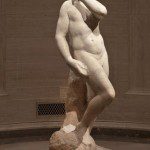Three Exhibits to See in the New Year
By • February 1, 2013 0 820
PISSARRO ON PAPER
Through March 31
The renowned French Impressionist Camille Pissarro is best remembered for his striking atmospheric landscape paintings, which instilled with signature character the mood and essence of his pastoral subjects. Printmaking was also an important part of his artistic process, and a series of them are currently on view in a beautiful one- room installation.
Pissarro began printmaking in his early thirties, and he valued the ease and efficiency with which he could test new ideas for his larger works. It also offered him the ability to manipulate surface texture and value in a way that drawing studies could not, resulting in the compositional density that is now so revered in his work. He became increasingly innovative as he grew more comfortable with different printing techniques, and ultimately purchased his own etching press to streamline his production.
Collectively, the works pay homage to Pissarro’s spirited experimentation, as well as his gradual but steady inclination toward landscapes, and the rural inhabitants of the farms and small towns that dwelt among them. His methods of printmaking left a history of his energy and physicality – one can witness throughout the prints his process of dabbing, rubbing, and dragging with a range of media, from brushes and palette knives, to his bare hands.
Any fan of Impressionism will relish the opportunity to spend time with these works. Just as Pissarro suggested through his paintings and prints, it is not always the grand productions in life that warrant our attention, but the small moments of wonder that get lost in between.
THE BOX AS FORM, STRUCTURE, AND CONTAINER
Through February 18
The Modern Lab is a small gallery inside the dedicated, focused installations of modern and contemporary works in a variety of media from the NGA’s collection. The current installation deals with the boxes, and the unnoticed but ubiquitous role they play in the contemporary environments. The concept of ‘box’ allows the artist in this situation to deal with their nature of accumulation, display and rearrangement.
Cameras, technology, and dioramas play a large role in this exhibit, addressing the lexical as well as aesthetic relationship with the idea of a box: a camera is a box where we store our memories, a computer a box where that gives us the space to think, but can also trap us in its hyper-engaging virtual reality. In these situations, it facilitates and obstructs our perception all at once, allowing certain things to come into focus while blocking out the rest of the world.
‘Box’ in relationship to death is also an issue dealt with in the exhibit. Some more piercing works recall coffins, tombs and Egyptian sarcophagi. Hair displayed in one case points toward a keepsake or locket, a small safe place for remembrance of a lost loved one. The body is dealt with as material objects in this exhibit, along with the notion that things change and take on different forms despite the protective boundaries of a ‘box.’ While it may sound gruesome, the installation deals with these subjects with a tact, intelligence, sensitivity and beauty that is thought- provoking and rather wonderful.
This theme also allowed artists to consider the architectural problem of combining two-dimensional surfaces and grid-like frames (think of an unfolded cardboard shipping box) to create three-dimensional objects. This show is for those who enjoy contemporary art for challenging them to think outside the box (forgive the pun).
Michelangelo’s David-Apollo
Through March 3
As The Washington Post notes, the last time Michelangelo’s David-Apollo was in Washington, in 1949, “the nation was preparing to inaugurate Harry S. Truman for his second term.”
At that time, the sculpture was brought over as a goodwill gesture by the Italian government, and it was displayed, rightfully, at the National Gallery. It is now back in its semi-centennial vacation home, on loan from the Museo Nazionale del Bargello in Florence for a limited time, in celebration of “The Year of Italian Culture,” a program of nationwide events in celebration of Italy’s rich heritage and continuing legacy.
A marble statue by art history’s grand master of sculpture, Michelangelo’s David-Apollo is a figure of a young man twisting in motion, with an arm slung across his chest. The pose captured in the face and body wears the signature expression of mercurial divinity in Michelangelo’s figurative work, suspended both in motion and in thought. With areas covered by a fine network of chisel marks, the statue is a breathtaking example of Michelangelo’s unfinished sculptural works, almost as illuminating as his finished masterpieces. The unfinished condition allows viewers to study the sculptural process and understand the commitment and mastery it truly took to create such a work of art. This sculpture alone is worth a trip across town—it’s too good to miss.




